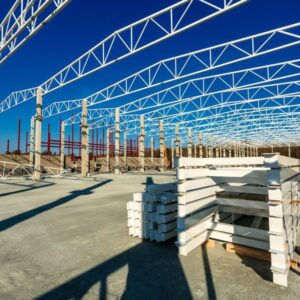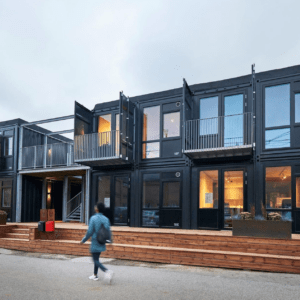Introduction
While steel as an alloy has been around for a while now, a number of factors have prevented it from being used on a regular basis as a structural material. One of the biggest factors for that has been the inefficient process of mass production for steel, in general, which is why the first usage of steel frame structures only goes back as far as the late 19th century.
Luckily enough, now steel is a widely known material that can be used for many different purposes – including steel frame construction. Steel frame, as a whole, is a building technique that uses the combination of horizontal I-beams and vertical columns to create a “skeleton frame” of sorts that supports floors, walls, windows, and the roof of a building – or the general weight of a structure if we’re talking about something non-residential.
Vertical columns and horizontal beams can be connected together in several different ways. Some of the more common methods are welding, riveting, and bolting. This kind of technique is also what made the “skyscraper” building type possible. That’s not to say that other building types cannot be constructed using steel frames, either – there are many industrial buildings, warehouses, and residential properties that use steel frame structures as their base with no problems whatsoever.
Shortcomings and advantages of steel frames
Each frame material on the market has its own downsides and strengths, and steel is no different – there are several positive factors about steel when compared with other materials, and there are also a few potentially troublesome factors to keep in mind, too. We’re going to start with steel frame construction advantages:
- Mass fabrication. When it comes to choosing between different materials, it’s rather important to remember that steel is a material that is the easiest to mass-produce in many different sizes and shapes.
- No pest- or insect-related weaknesses. Steel is straight-out immune to the degradation caused by either mammals or burrowing insects.
- Durability. Steel is both stronger and lighter than your typical wooden frame, removing the problem of durability from the board in its entirety.
- Resistance to fire. The fire resistance of steel is top-notch, with little to no potential fire spread, and the ability to improve this particular parameter with flame-resistant coatings. But there is a catch – which we’ll go over when it comes to disadvantages.
- Moisture and other factors. While steel is not immune to various types of moisture, its resistance against corrosion is rather formidable. It can be boosted either by changing the nature of the alloy or using various coatings and treatments to improve steel’s rust resistance – it’s incredibly important for specific structure types like bridges that are constantly exposed to various weather effects.
However, there is no perfect material – and that includes steel, as well, which has its own set of downsides and disadvantages. For example:
- Precision is a requirement. With timber frames, there is always a bit of room for adjustments on-site – be it cutting components in size, strengthening joints with nails, and so on. Unfortunately, you cannot do that with steel – all of the calculations with steel production need to be as precise as possible, since all of the parts for a steel frame are delivered in their final form on-site. Additionally, even one miscalculated steel part has the potential to stop the entire construction process before this particular part is created in the correct way.
- Low energy retention. While steel is rather heat-resistant, its thermal conductivity parameters are way too high for it to be an effective material when it comes to a building’s energy retention. This problem could be partially remedied by various insulation measures, but it’s still a problem that you’ll have to live with one way or another.
- A lot of supplementary structures. Steel frame structures are also quite dependent on various supporting structure elements, be it insulation, drywall, sheathing, or even various wooden components. It also makes for a longer construction process, but most of the time prefabrication time savings outweigh any of these potential delays.
Steel framing types
As for the steel frames themselves – there are actually several different types of those, with each type having its own specific use case and unique construction procedures. There are three main types of steel frames – wall bearing, skeleton framing, and long-span framing.
Wall-bearing steel frames rely a lot upon masonry walls that the steel structural members are anchored to. This structure is supposed to support both the horizontal and vertical weight of a structure, so the span distance between supports tends to vary a lot – lower depth beams are preferred, and they do offer more headroom height, but they also raise a requirement for column spacing. The main reason for that is, once again, the weight load of a structure – and the closer spacing of bearing columns could potentially limit the clear space area.
Skeleton steel frames, on the other hand, are somewhat more simple in comparison. It is still a connected network of columns and beams that supports the entire structure’s weight, but it also uses spandrel beams for masonry walls and is generally more suitable for large multi-story structures more than anything else.
Long-span steel framing is another somewhat unusual type of steel frame, this one is more about large structures with massive clearance requirements – more than 12 meters between structural walls or beams. It is the preferred method of construction for theatres, industrial buildings, and pretty much anything else that requires heavier loads and taller arches.
Timber frames and steel frames – what’s the cost?
While there are many other factors that could be considered when putting different frame materials face-to-face, there is one that pretty much trumps above them all – and it’s the cost of building a frame using a specific material.
It is fair to say that all of the advantages of steel are outweighed by its cost – steel, undoubtedly, costs more than timber when it comes to building frames. For one, steel framework production is an extremely tedious process and requires a high level of knowledge and experience in the field.
This is pretty much where this entire cost difference comes from, including installation costs, production costs, and so on. There is a large margin of correction depending on the steel quality, the complexity of a structure as a whole, as well as many other factors.
It’s also fair to say that, when it comes to smaller house frames (personal small and medium-sized homes), steel is a more costly alternative to timber. It’s not uncommon for steel frames to cost several times more than timber ones, as well.
Conclusion
As you can see, steel frames as a whole have their own use cases where they’re at their finest – mostly with industrial structures, multi-store buildings, and so on. However, we’ve also tried to be reasonably objective and listed both advantages and disadvantages of steel frames as a whole, so that your decision is informed and based on the full knowledge about the subject.










